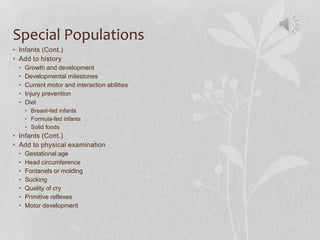Chapter 26 303 s16 voiceover
- 1. Sarah Loch RN MSN Fall 2015 CHAPTER 26 RECORDING INFORMATION
- 2. Recording Information • After performing the history and physical examination, the nurse must: • Organize • Synthesize • Record the data • Record the problems identified • Record the plan of care • The patient’s record is a legal document. • Court • Health care payment determinations • Present the data legibly, accurately, and in a manner that is representative of the examination.
- 3. General Guidelines • Take brief notes during examination. • Use facility-approved abbreviations sparingly. • Document observations and what patient tells you, not your interpretations. • Record expected and unexpected findings. • Customary outlines of information • Problem-oriented medical record (POMR) with SOAP/DAR is one such system • Subjective • Objective • Assessment • Plan
- 4. Subjective Data • Subjective data are the information that patients offer about their condition. • Describe the patient’s concerns or unexpected findings by their quality or character. • Useful way to record expected findings is to indicate the absence of symptoms (e.g., “no vomiting, diarrhea, or constipation”).
- 5. Objective Data • Objective data are the findings resulting from direct observation—what you see, hear, and touch. • Relate physical findings to the processes of inspection, palpation, auscultation, and percussion. • Provide an accurate description of unexpected objective findings. • Location of findings • Topographic and anatomic landmarks • Incremental grading • Findings that vary by degrees • Organs, masses, and lesions • Texture or consistency • Size • Shape or configuration • Mobility
- 6. Objective Data • Discharge • Color and consistency • Illustrations • Origin of pain and where it radiates • Size, shape, and location of a lesion • Stick figures • Photographs
- 7. Problem-oriented Medical Record (POMR) • Commonly used process to organize patient data gained during the history and physical examination • Format for collecting and recording your thoughts that assists with critical thinking and clinical decision making • There are six components of the POMR: • Comprehensive health history • Complete physical examination • Problem list • Assessment and plan • Baseline and problem-directed laboratory and radiologic imaging studies • Progress notes
- 8. Problem list • Problem List • A problem may be related to any of the following: • A firmly established diagnosis • A new symptom or physical finding of unknown etiology or significance • Unexpected and new findings revealed by laboratory tests • Personal or social difficulties • Risk factors for serious conditions • Factors crucial to remember long term • Problem List (Cont.) • Controlling variables with regard to the sequencing of listed problems include: • Relative gravity of the problem • Probability/possibility ratio • Likelihood of the probabilities in a differential diagnosis • Availability and cost of resources relative to need and availability • Time sequence in which the problems arose
- 9. POMR • How it is arranged: • The history • The ROS • The Physical Exam findings
- 10. Special Populations • Infants: • Organizational structure for recording the history and physical examination of newborns and infants is the same as for adults. • Recorded information varies from the adult’s primarily because of the developmental status of the infant. • In newborns, the focus is on the transition to extrauterine life and the detection of any congenital anomalies.
- 11. Special Populations • Infants (Cont.) • Add to history • Growth and development • Developmental milestones • Current motor and interaction abilities • Injury prevention • Diet • Breast-fed infants • Formula-fed infants • Solid foods • Infants (Cont.) • Add to physical examination • Gestational age • Head circumference • Fontanels or molding • Sucking • Quality of cry • Primitive reflexes • Motor development
- 12. Special Populations • Children and Adolescents • As during infancy, some adaptations in recorded history reflect the developmental progress of the child. • Children and Adolescents (Cont.) • Add to history • Major neonatal problems until school-age • Behavior in family • School performance • Growth and development • Add to physical examination • Puberty changes
- 13. Special Populations • Pregnant Women • Organizational structure of the record does not vary from that of other adults. • Information about the pregnancy is added. • Pregnant Women (Cont.) • Add to history • Gravidity/parity • Obstetric history • Menstrual and gynecologic history • Adjustment to pregnancy • Add to physical examination • Fundal height • Fetal heart tones • Pelvic measurements • Uterine size • Older Adults • Add to history • Community and family support systems • Functional assessment
- 14. Special Populations • Older Adults • Add to history • Community and family support systems • Functional assessment • Older Adults (Cont.) • Add to physical examination • Skin lesions • Baldness and thinning hair • Chest shape changes • Muscle mass or posture changes • Cognitive function • Gait and balance













